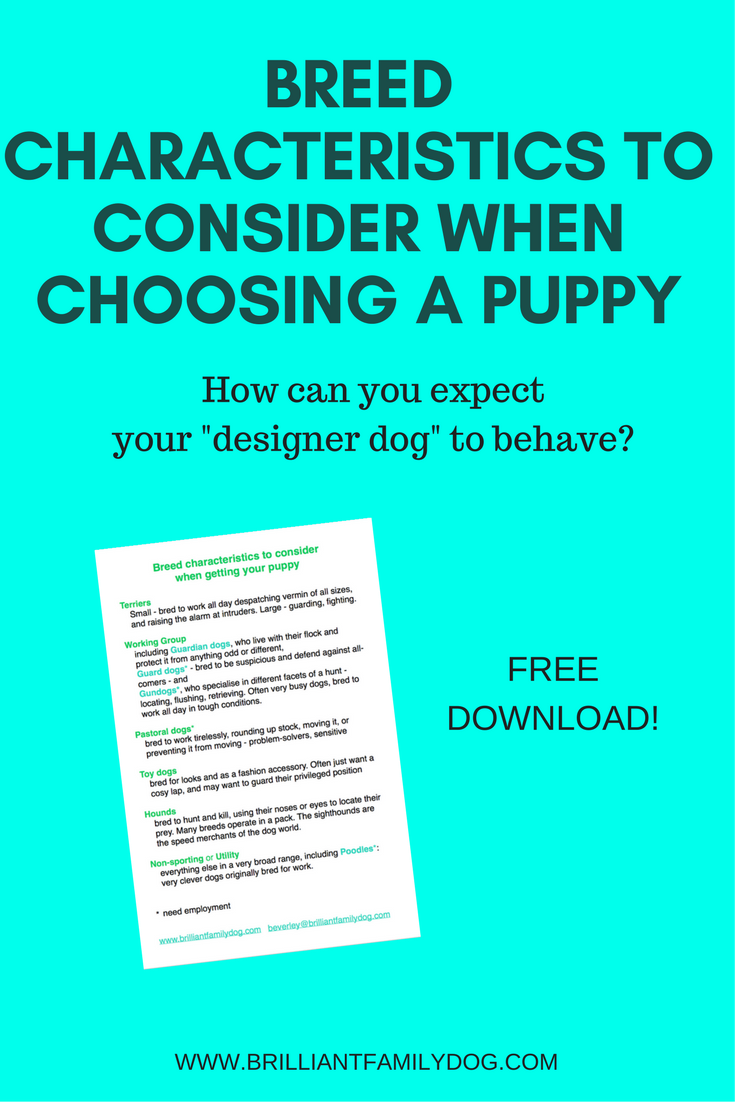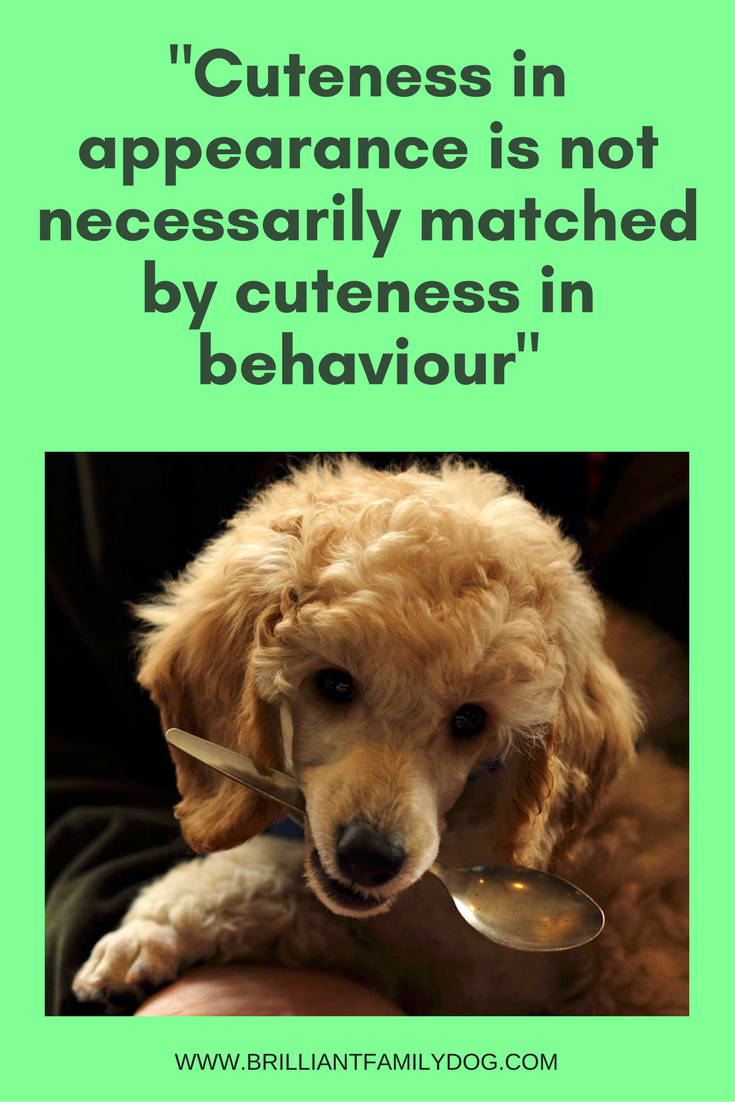It’s all the rage - dogs with cute monikers.
You can find a Jackapoo, Cockerpoo, Labradoodle, Goldendoodle, Jackahuahua, Maltipoo, Puggle, Schnoodle, Cavapoo, Yorkipoo … and I have yet to discover the name of a Shih-Tsu crossed with a Poodle.
In many cases, people are seduced by the cuteness of the name and the celebrities who have also been seduced - and bought one.
It tends to be first-time puppy buyers who go down this route, as they often have little understanding of breed characteristics.
It’s not just about looks!
The problem is that as many of the crosses are inappropriate, you end up with a much more challenging dog than if you had gone for either a pedigree dog from a first-class breeder, or a genuine mixed-breed mutt from the shelter.
As a friend put it recently, describing a cocker spaniel x poodle (a so-called “cockerpoo”) she’d met:
“You have a dog who couldn’t care less about people crossed with a dog who wants to rule the world - not a good combination.”
I have found that this tremendously popular cross creates a lot of problems for the new puppy-owners I work with. It’s one of the most difficult crosses to manage and needs skill and knowledge of the characteristic behaviour of both breeds involved. I’m quite sure that the funny name is what has swayed many of these buyers. This is why I never use the cutesy titles people give me for their dog (which they usually say in an exaggerated way and accompanied by a shy giggle “It’s a cockerpooooooo!”). I call them what they are: a spaniel x poodle. That way I can keep their make-up in the front of my mind when working with them.
Oh, and having one parent from a non-shedding breed means you have on average a 50% chance of your puppy being non-shedding, or suitable for allergy-sufferers and the houseproud. Puppies barely shed any hair in the first year anyway, so the new owner doesn’t find out the truth for some time.
What happens when you mix them up?
to help you see the different characteristics of different breeds -
and what a combination could result in!
THIS GUIDE IS A BONUS FOR YOU WHEN YOU SIGN UP TO RECEIVE EDUCATIONAL EMAILS AND OCCASIONAL OFFERS FROM ME. YOU CAN UNSUBSCRIBE AT ANY TIME.
Privacy Policy
You need to look at the characteristics of the breeds you are crossing. A terrier, for instance, has been bred for centuries to hunt down and kill small rodents. This is why they are so popular on farms and in stables. They need to have an outlet for this instinctive drive. If you expect them to perch on a velvet cushion all day long because they’ve been crossed with some kind of fluffy, you are going to build up tremendous frustration and conflicts in your little dog.
Cuteness in appearance is not necessarily matched by cuteness in behaviour.
We all know people who look just like one parent while having all the personality traits of the other.
Another friend was toying with the idea of mating his two dogs - a reactive, longhaired, collie bitch and a cuddly, fast, whippet. He thought he would get lots of fluffy cuddly puppies. Genetics is a tricky and unpredictable game - even for those who know a lot about it. I warned him he may instead get a litter of very fast reactive dogs.
Fortunately he realised that in any case his reactive bitch should not be bred from. “Reactive” is a catchall word for fearful, anxious, defensive. There would be a high likelihood of all the puppies following their mother’s example and being reactive too. The world does not need another six or ten reactive dogs!
And this leads me to the source of most of these “designer” dogs.
What difference does the breeder make?
Good pedigree breeders spend a lot of time and money on producing the best puppies they can. The genetic testing they do is expensive and time-consuming. They choose pairings with enormous care, studying the history of the lines for behaviour, temperament, and health, and will only breed from the very best.
They then devote months to caring for the bitch and rearing these puppies in an enriched environment - usually their kitchen and living room - taking special care over their socialisation and temperament, then carefully vetting prospective owners. The best remain available for advice and guidance throughout the life of the dog.
Do you think the same level of attention is given by the puppy farmers who produce many of these crosses? Do you think they pay for those expensive tests? Do you think they start off with the best possible stock? No pedigree breeder would let their puppies go to such a person, so they’re starting off with inferior animals right off the bat.
UK TV Vet Marc Abraham says, “You end up cross-breeding breeds which each often have their own genetic faults. So Labradors are prone to hip problems, and Poodles to eyesight problems. Cross-breed them and you get puppies prone to both conditions.”
Another Frankenstein
While these dogs tend to attract the inexperienced, they are by and large not a dog for the first-time buyer.
Even the person who bred the first, notorious, “Labradoodle” (a mistaken attempt to provide a guide dog for a blind person with allergies), Wally Conron, says, “I opened a Pandora's box, that's what I did. I released a Frankenstein. So many people are just breeding for the money. So many of these dogs have physical problems, and a lot of them are just crazy. I've done so much harm to pure breeding and made so many charlatans quite rich. I wonder whether we bred a designer dog—or a disaster!"
People will pay absurd amounts of money for these unfortunate puppies. They don’t realise they are being duped by callous people who are cashing in on a craze. They fall for the puppy mill tricks and believe the puppy they’re getting is from the bitch that they’re shown, and reared in the comfortable house they visit.
Some sharper buyers have doubts, but they still go ahead with the purchase as they want to “rescue” the puppy - thus perpetuating this evil trade.
Sadly, many of these puppies are bred from sickly breeding-machine bitches who are kept caged in appalling conditions, with none of the social environment that makes for a stable and healthy dog.
The UK Kennel Club, who campaign actively against the puppy farmers, conducted research that indicated that one in five puppies bought via social media or the internet dies before it’s six months old. “It is irresponsible breeding and it is done purely to make money”, says the KC Secretary Caroline Kisko.
Before all you owners of designer dogs berate me in the comments, saying how lovely and healthy your dog is - I can tell you that you are one of the lucky ones.
So what dog should I get?
There are people who spend more time and attention buying a new washing machine than they devote to choosing the right dog - a real live creature with an individual personality - to share their home for the next 12 - 15 years.
So what options are there for getting a healthy, well-bred, carefully-reared puppy?
1. You can go to a careful, genuine, breeder.
In the UK the Kennel Club has a list of approved breeders - but you still need to do your own vetting! That’s especially so with a breed that has serious genetic problems, like the Cavalier King Charles Spaniel, at least 70% of whom will have developed a debilitating and painful brain disease by their sixth birthday.
2. You can get a neighbourhood mutt born to a family pet in a home local to you.
For someone whose beloved family pet has a litter of pups this is the highlight of their year, and massive amounts of time and love will be lavished on the pups. If there is enough cross-breeding there will be plenty of hybrid vigour. You will be able to meet the dam and quite possibly the sire too. Puppies reared with loving care in a busy family home have the best start in life.
3. Or, of course, you can take pot luck on a rescue dog from a shelter.
This can be a winner all round. But unsurprisingly, many of them have baggage and behavioural problems, and some of those posh crosses end up in rescue because they’re so hard to manage. You need to be prepared to work with someone else’s cast-off and you may need specialist behavioural advice (make sure it’s force-free!). But the results can be fantastic and rewarding.
Either way, you should spend months on this project.
And don’t be deceived by something as paltry as a name. Wally Conron, the Labradoodle man, freely admits that the name was invented as a marketing ploy, as nobody was interested in having a “mongrel”. Would you really spend more money on the washing machine you’re researching if it was called a “Washypot” or a “Clothesyclean”? Or if a film starlet had one?
For free training for your new puppy - of whatever type! - get your free email course here.




